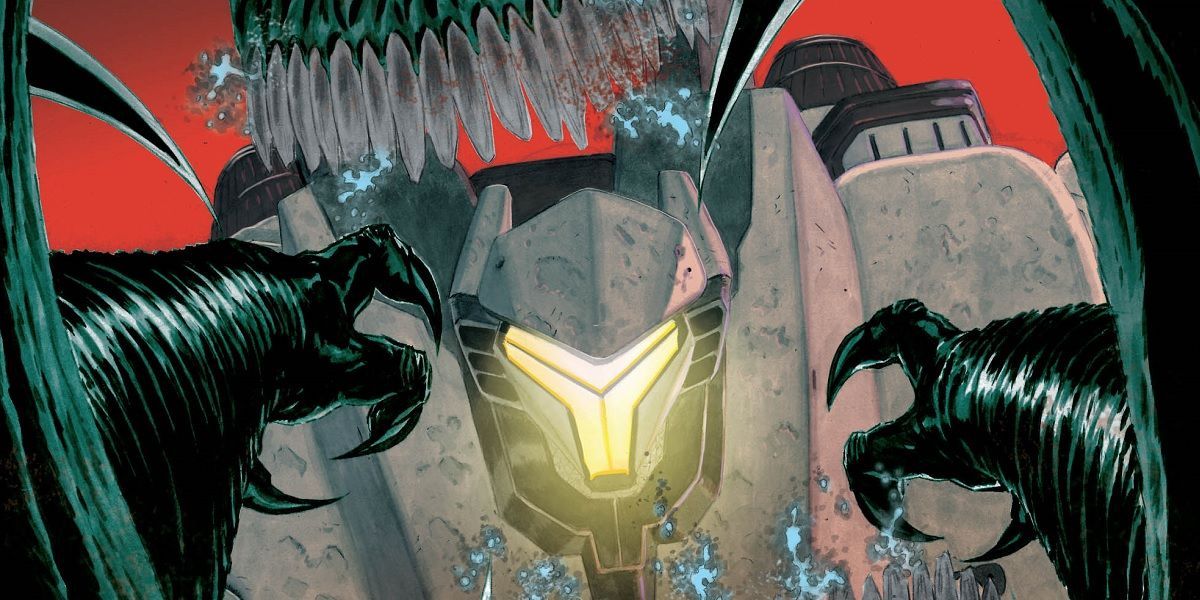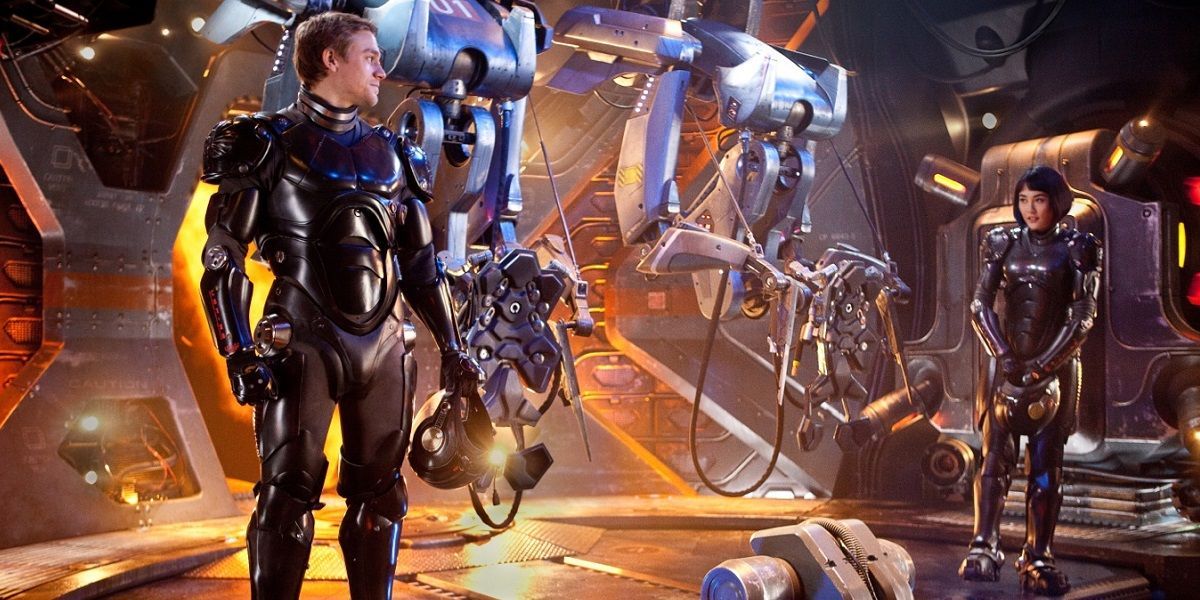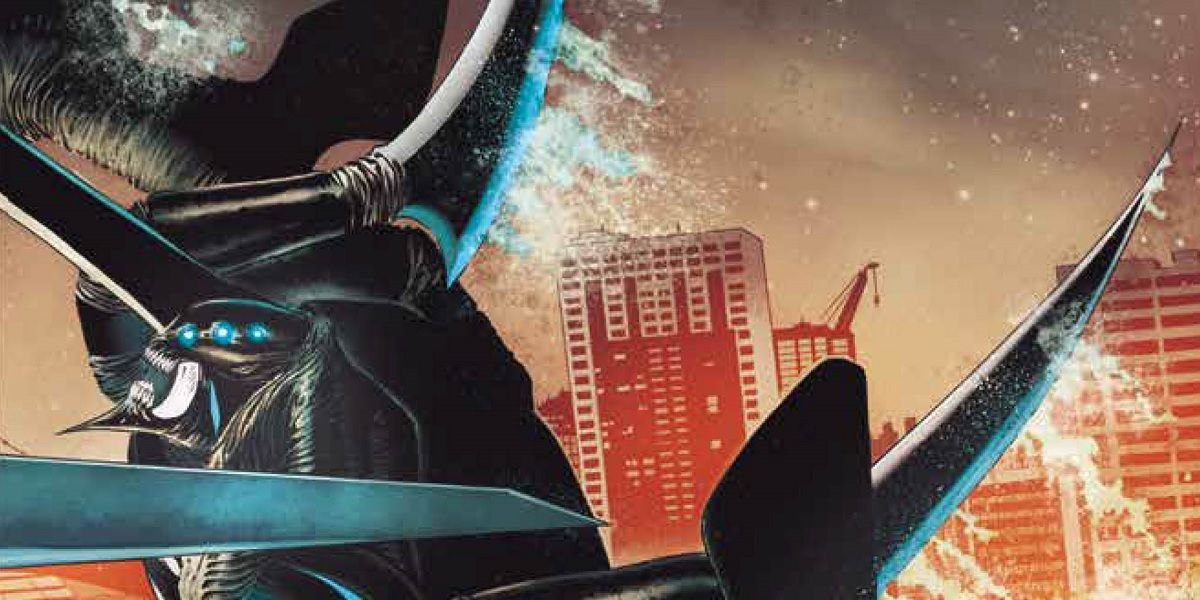For a writer best known for penning large scale stories, Travis Beacham's enthusiasm for small stakes comes as something of a surprise. 2010's Clash of the Titans, which Beacham wrote an early draft for, threw the balance of power among Greek gods into turmoil; more notably, 2013's Pacific Rim, which Beacham co-wrote with Guillermo del Toro, put the very survival of humanity on the line. However, the spectacle in these films combines with Beacham's interest in human stories. Personal conflicts and struggles make up their cores. This is true, too, of Pacific Rim: Tales from Year Zero, a graphic novel released on the cusp of the Pacific Rim's theatrical premiere. That collection served as a prequel to the events in the film, and now it's joined on shelved by Pacific Rim: Tales from the Drift, a follow up to the narrative set up in the original comic series.
In Pacific Rim, two-person teams pilot massive, mechanical war machines called Jaegers in combat against Kaijus, equally gigantic (more so at times) alien beasts invading Earth via an interdimensional rift settled at the bottom of the Pacific Ocean. On the screen and on the page, the battle between man and monster rages on, larger than life, and yet these yarns always circle back around to central themes of human unity and cooperation. Watching a Jaeger rocket-punch a Kaiju in the kisser is fun, but Pacific Rim's blockbuster identity stems as much from its spirit and its approach to building a universe as it does from its titanic action sequences.
With Pacific Rim: Tales from the Drift hitting stores this week, Screen Rant caught up with Travis and chatted about the comic itself as well as Pacific Rim as a budding franchise. Collaboration is part and parcel of Travis' work, so we talked about his approach to gelling with people like del Toro, writer Joshua Fialkov, and artist Marcos Manz, and how he blends the ideas he comes up with for stories with the ideas of his colleagues; we also touched on the topic of Pacific Rim 2, the in-flux sequel to Pacific Rim, which remains on hold with a completed script:
Let’s go back to 2013, because that’s when Tales From Year Zero was published. At what point after that did you start germinating the material for Tales From the Drift?
Well, it’s interesting, because even before we did the movie, we had a fairly specific idea of what a lot of the backstory was. The movie itself, it begins pretty late in the whole, you know, conflict, and so there was always this sort of vast sweep of time where the Jaegers had been around, and the Kaiju had been coming, and there’s all kinds of stories to be told that that weren’t necessarily in the movie. In this in particular, in Tales From the Drift, the characters themselves had always been in mind my as something that was part of the universe, and something I at some point wanted to tell a story about. The story here, the stakes are a bit smaller than the movie. It’s set against the backdrop of a battle, and it’s more centered on their relationship. So it’s a tighter story than in the movie, but I think it’s still a very interesting story. It’s something that I hoped to have the opportunity to tell for a little while now.
I like that, that idea of a small stakes, small scale story in a universe that's this big, especially in light of what’s at stake in the film. How did you find writing a more intimate story in this world, developing a more intimate story in this world versus developing the archetypal, “the heroes have to stop the world from ending” kind of story?
Actually, it’s sort of where my brain tends to go anyways. I think the bigger challenge for me is finding a way of talking about the end of the world, and that kind of thing, that matches reality. Whether I’m watching or writing those sorts of stories, I’m always looking for, like, what are the relatable points here? What’s the relationship drama, that sort of thing. Those are the sorts of things that, when you’re watching a movie like that or any kind of genre thing, if you believe the characters, and buy their basic conflicts, I think that it gives you a lot of permission to be very inventive about the world and everything else that’s going on around them. So that’s always the first step for me, is asking, “What’s the human story here?”
Even when I was writing the movie, it was very important to know that about people. I always wanted to do, I think, one of these giant mechs versus giant monster movies, and with a modern budget and modern aesthetic. But, I mean, that’s not really a pitch, you know? Anybody can go into any room and go, “I want to do that.” I didn't know I had anything at all until I realized, “Oh, it takes two of them to drive this thing!” Then I knew what it was about. It was about people, and relationships, and the drama between two people that drive these things. That’s when I finally realized that this movie had a story about characters that people could be interested in.
For me, the theme of human spirit and human collaboration is the strongest of the movie and the graphic novel, but I also come back around to world building when I think of Pacific Rim. Is that another major interest of yours? I feel like Pacific Rim, on the page and on the screen, is really centered around that.
Yeah! It’s something that I’ve always been interested in, and one of the things that I really like about movies in general is their capacity to take you somewhere else and drop you there. I think where it feels kind of artificial, and where it doesn’t work, is when you understand a lot of the world, and the story begins right where it’s supposed to begin, and you see the whole thing play out, and then you see the whole thing end. I like being dropped in, and there being a past that isn’t talked about very much, or there’s areas around corners that you know are fleshed out, but nobody’s talking about. It’s always the stuff, I think, that you don’t get into that makes the world feel real. Because when you go to a new city or a new place just in our real world, you don’t get somebody following you around, explaining where everything is and how everything works. You learn using context clues, and I think worlds that are fleshed out in that way, where the creators know more than they’re telling you, are always the ones that feel a bit more like reality.
You strike me as a very collaborative guy; you’ve worked with Guillermo [del Toro], and now you’re working with Joshua Fialkov on the movie and the comic book, respectively. What, for you, is the challenge of melding your approach and your sensibilities with the approaches and sensibilities of others?
That’s a good question, because I think coming into film, and when we watch film at an early age, there’s this whole mythology of the auteur. We tend to see films as artifacts of one mind. The reality of it is, I think, when you come out here and start working, you have to learn pretty quickly that it’s a very collaborative process. You have to be open to other people’s ideas, and you can’t be too married to your own. You have to be uncompromising, and you have to know what you like about what you like, but at the same time you can’t be so uncompromising that you’re difficult to work with. That’s just part of what I’ve really grown to appreciate about film, and comics too, is learning to trust the creativity of others and be open to the ideas that they bring to the table that aren’t necessarily like anything that you could think of on your own.
I think that’s where the magic happens, when you get a bunch of people who are really, incredibly talented, and good at what they do, and very passionate about the project that they’re working on, and in love with it, I think that’s when you get something that’s really special. I think people can tell the difference when they watch a movie that was put together in that spirit, and when they watch a movie that wasn’t. It reads on screen very clearly.
So it’s kind of like getting Jaeger pilots together to fight Kaiju in the spirit of unity, and collaboration, and teamwork.
Oh very much! Exactly, exactly. And I think that’s something that was never very far from the surface in my mind, you know, as I was writing it. Even when you’re doing these things that seem very fantastical, and that take place in very strange worlds, it’s interesting, I think, because when you know certain things about the fighter’s life, or whoever’s putting it together, if you know certain things about their lives, you can see weird sorts of dramatic parallels between mundane things that are happening and these fantastical things that are happening on screen.
So what did Josh and the artists - Marcos Marz, Whilce Portacio, Pat Lee, Francis Manapul and Livio Ramondelli - bring to the story here?
They really brought the whole execution. When I turned in a treatment for this, I would have been delighted and happy to write it myself. I had a really great time writing the first graphic novel, but at the time I was really hip-deep in working on a network television show, which just really eats up your time like nothing else a writer can possibly do in this industry. So I gave them a pretty detailed treatment and said, “Yeah, run with it.” So yeah, I think a lot of the execution and artistry behind that is entirely theirs, and that’s another thing about collaboration: It’s fun to see the things that when you look at it, you’re like, “Oh, that’s exactly what I described, that’s exactly what I was picturing,” but it’s equally fun to see the things that exist within the same context but are the type of things that you might not have necessarily thought of on your own, like, “Oh, that’s a really clever wrinkle on that!” But yeah, it’s been really gratifying to see it all come together.
So it sounds like you worked pretty closely with the team even after the plot had been set in stone, which I think is very cool.
Yeah, yeah, it was, and I’ve loved seeing it come together. In some situations, especially in film, you do an outline or something, and then you’re out of the loop, and then when you see it, maybe you recognize it, maybe you don’t, but this has been a very different sort of experience. As with all things Pacific Rim, to see it come together in a way that’s very much along the lines that I was thinking is not something that usually happens in this industry very often. But Legendary’s been a very great creative partner throughout the process, and everyone involved has been very appreciative of my role in the whole thing, which has been extremely rewarding.
I’m super curious: Working with writers and artists on the page this way, do you try to plot out, or change the narrative, to suit the styles of the artists? Do you consider the story in terms of how X artist likes to work, or how Y artist likes to draw?
Sometimes. Sometimes. Especially when you’re writing a script for a comic, one of the things I like to do, I’m not terribly specific in my stage directions, because I want the artist to contribute, and I want them to know that they’re contributing, and feel like they’re contributing, and feel free to have ideas rather than being super specific about, like, “Oh, in the top left corner of this frame, there’s a window.” You know what I mean? I feel like, if I was an artist, I would be very bored with that kind of script, and the last thing you want from any collaborator is someone who is very talented and very capable feeling like they’re bored working on something that they’re working on. You’re just not going to get good results.
Of course. That makes a ton of sense. I just think it’s very cool to see this universe, which I think is a large universe, it’s cool to see different creative talents being brought into that universe. I find that exciting as a fan of the film. Jumping off of that a bit, do you have a good feeling about where Pacific Rim 2 might end up going?
Yeah, I mean, we have a lot of thoughts about that, and it’s gonna depend on, you know, whether or not the film gets the green light and that sort of thing. But we have a multi-movie strategy of where it would go, which is pretty challenging because, you know, we stopped the apocalypse, right? But thankfully, I think with Pacific Rim, the stakes are always going to be centered, I think, a bit more on character, and that kind of thing, which always leaves you open for more stories, because there’s always going to be people in the world, and they’re always going to have problems, and it’s just a matter of finding the most interesting way of telling that using all the pieces of the world that you have.
I realize that might be sort of, not a touchy subject, but a challenging subject to talk about, because I know the movie is kind of in a holding pattern. It doesn’t even have a date anymore.
Yeah. It’s a bit par for the course. I mean, I’m not terribly cynical about the industry. I do tend to be on the more optimistic end of things. Even so, I wish I could say it was an uncommon experience, to not know how something’s going to turn out like that. But it’s a business where anything can happen. I don’t think it’s bad, you know. I don’t think its prospects are grim. I just think they’re uncertain, and it’s gonna take people above my paygrade making decisions, based on criteria that I am not necessarily privy to, to make it happen.
Assuming the best case scenario, I kind of want to go back to something you said: Where do you go from here after you’ve stopped the apocalypse? You have Tales From the Drift, and you have the sequel fomenting as you speak. What kind of new ideas are you hoping to tackle the more you tell stories within Pacific Rim’s world?
Well, I think there’s a lot of stuff about, specifically, the drift itself was a very interesting part of the first film, but that wasn’t explored, I think, entirely. There are a lot of interesting ideas about that that could form the backbone for new stories, and I think there’s a lot about the aliens from the other universe that were mapped out but not necessarily explored in the comics that could be fodder for more stories. In general, I think a sequel would open on a world that is sort of rebuilding from everything that’s happened in the movie, and in the preceding decade. So I think it’s going to feel different from the first one in a lot of ways, but not necessarily bad ways. I think the best sequels are ones that find a new story and a new way to tell the story, but in the context with characters that are familiar.
-
Pacific Rim: Tales From the Drift Issue #1 is now available for purchase.



